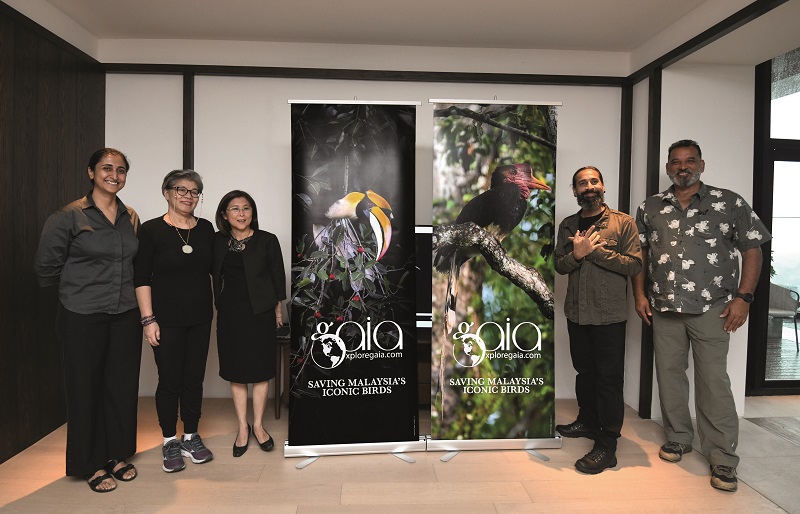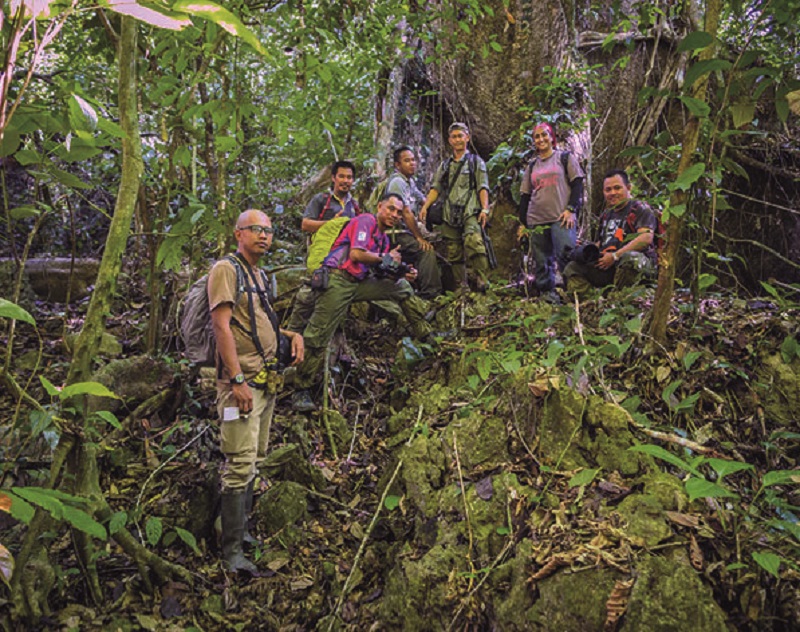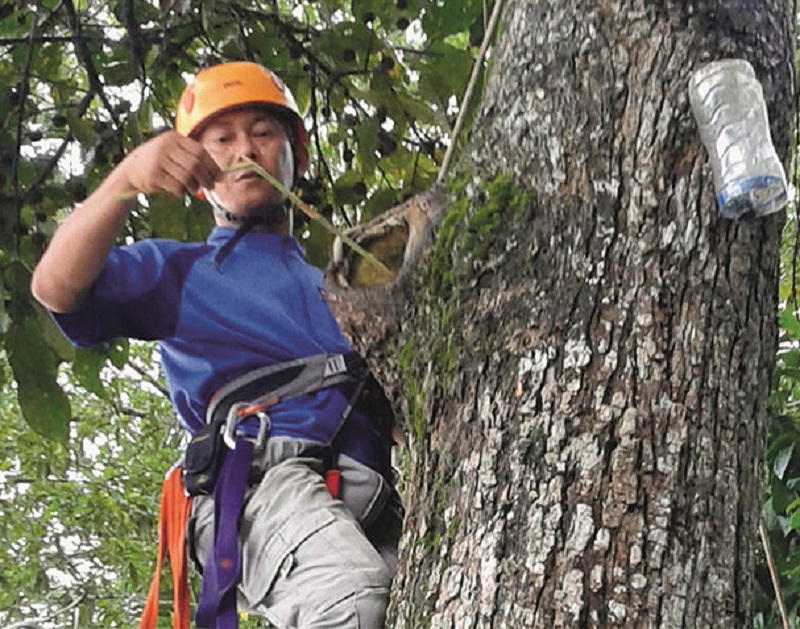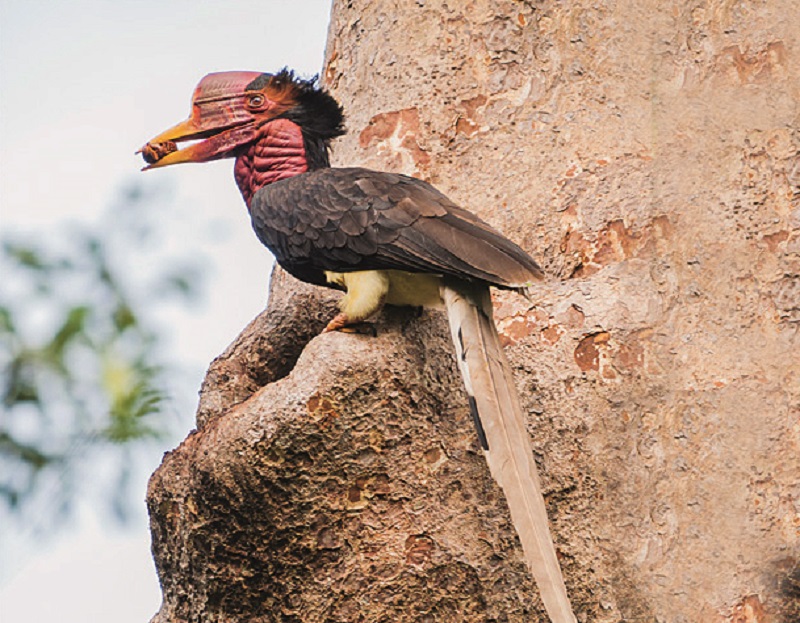
Alila general manager Nancy Cheah (left) and scientific director of Gaia Dr Ravinder Kaur (Photo: Low Yen Yeing/The Edge Malaysia)
It was a classic case of a miserable student moving from the back of the class to the front after she started scoring As for a subject she had no interest in initially. A visit to Danum Valley, Sabah, then sealed her fate when a lecturer pointed to some marks on the ground and said, “Here, an elephant walked by”.
“That blew my mind! I didn’t know we had elephants. I didn’t know our rainforest was so beautiful, so diverse,” says Dr Ravinder Kaur, scientific director of Gaia, a social enterprise dedicated to wildlife conservation in Malaysia.
Gaia, Greek for Earth, was set up in 2015 by Ravinder and her wildlife photographer husband Sanjitpaal Singh to research and conserve endangered hornbills throughout the country.
In February, Alila Bangsar Kuala Lumpur teamed up with Gaia to conserve the critically endangered Helmeted Hornbill. Of the 10 hornbill species found in the country, this one is on the brink of extinction. The last surviving pair is in the jungles of Kinabatangan, Sabah.
Fittingly, the collaboration kicked off in the month of love because those monogamous creatures, recognisable for the bright upturned casque on their beaks, have come to symbolise affection and intimacy, evident from how the males care for their nesting mates.
Making Homes for the Love Birds at Alila aims to create awareness of the big birds and raise funds to build nesting boxes and restore dilapidated tree cavities in our jungles, to encourage them to mate and multiply. On sale at the hotel are prints of Sanjitpaal’s hornbill shots, rock art by Suzi Chua and ylang-ylang essential oil, touted as a love potion because of its romantic scent. Hornbills play a pivotal role in dispersing the seeds of this fruit plant.
20230209_peo_hornbills_gaia_wildlife_conservation_1_lyy.jpg

Partners in the project are Sime Darby Foundation, Hutan, the Sabah Forestry Department and the Sabah Wildlife Department. Naturalist Irshad Mobarak shared his encounters with hornbills in Langkawi, where there are three species, especially a pair he got acquainted with 27 years ago.
Alila general manager Nancy Cheah says supporting community work and preserving and conserving the environment are part of the hotel’s DNA. The pandemic put things on hold but it is going back to that by offering Gaia a platform to reach a different audience and a space for events or to showcase Sanjitpaal’s photos.
Ravinder, who sees conservation as a team effort, works with partners to create nest boxes and restore natural tree cavities to make them hornbill-suitable, with a bit of carpentry. Nesting opportunities are hard to come by because of historical logging between the 1970s and 1990s. The artificial boxes are usually for large-bodied hornbills while the restored cavities are for the smaller-bodied birds.
Hutan began setting up nest boxes in 2013 and Gaia stepped in to help from 2015. There are 32 now, created using plastic. In 2017, one of the boxes was successfully used by a pair of rhinoceros hornbills — a world first. This encouraged the Gaia team to continue building more of them.
Going back to how it all started, animal lover Ravinder says she was disappointed to get a place in University Malaysia Sabah to study conservation biology as she had hoped to work with dogs and cats. She went, reluctantly, and spent the first year depressed and disinterested. “I lost a lot of weight.”
gaia-horbills-gallery6.jpg

The turning point was when a lecturer started teaching zoology. After her visit to Danum Valley, she returned to the conservation area to do a three-month internship. She got a job with the Malaysian Nature Society and was put on its hornbill project. Thus began her love affair with those creatures. Part of her PhD chapter was on the ideal temperature inside the tree cavities where the females nest.
Today, she and Sanjitpaal trek into the jungles in search of natural cavities, especially during the nesting season. They found many of them lying empty, and some were too small for the large-bodied hornbills. Thus Gaia’s endeavour to give them a helping hand.
The season of love varies throughout Malaysia for hornbills, but it follows the rainfall pattern. “The birds like to nest during the dry season.” It stands to reason, Ravinder adds, because “if you’re going to be in a hole, you don’t want it to be wet. You would want the forest to be offering you fruits”. The hornbill’s favourite feed is figs.
The pandemic years were hard on this couple, who found themselves jobless and had to turn to Ravinder’s mother for help. “Conservation is not a job. I always say it’s just my hobby, but it takes 80% of my time.” Now that things are back to normal, the Gaia team has returned to corporate social responsibility work and preserving whatever it can.
gaia-horbills-gallery4.jpg

In the last three tough years, Ravinder never thought of giving up. “What would I do if I gave up? But I would say you are challenged in so many ways: physically hiking in the forests, writing proposals [to get funding], pitching your project. I’m an introvert by nature, but I have to be an extrovert, a forced extrovert.”
On the bright side, working with hornbills has taught her about family. Ravinder noticed a pair of hornbills whose chick either died or did not hatch and how the mother was mourning. “She remained near the cavity holding a gecko. It was a maternal instinct to feed her baby but there was nothing there.”
True love in the treetops
No one tells a romantic story better than Irshad Mobarak, who makes listeners go “ooh” and “aah” over his encounter with a female hornbill he literally embraced. Here are some fascinating facts from the naturalist and social enterprise Gaia’s website about those creatures, so-called because of their large curved bills, that mate for life and engage in a pecking display of love at their nest.
The female hornbill chooses her mate, not the other way round. Once she has decided on her partner, the other suitors have zero chance of changing her mind.
Hornbills and toucans may appear similar but they are from different families. Toucans are from the Ramphastidae family and hornbills are from the Bucerotidae family.
gaia-horbills-pic_for_sidebar.jpg

Hornbills go for tall trees. They have been known to nest in those reaching between 27m and 70m and prefer the trunks of the Dipterocarpaceae, a family of largely South Asian and African timber trees.
Picking which tree to nest in is also the female’s prerogative. Once she settles on one, she swoops into a tree cavity and begins to plaster herself with the pulp of regurgitated fruit and some faecal matter. Then she starts to seal the entrance to the tree cavity, leaving just a small window to stick out her bill.
She will remain confined for up to 13 weeks while her spouse flies off to look for food, returning at one- or two-hour intervals, depending on how far he has to go, with fruits, insects and lizards.
The female will take the food from him and give it back to him. They do this several times before she consumes it. Inside the nest, built like a fortress, she cares for her chick, protecting it from monitor lizards, civet cats and snakes.
After more than three months, the mother hornbill will break out of the nest, leaving her chick to reseal it. Together, mum and dad will feed their babe for about three weeks, until it is time for it to squeeze out of the nest and take its first flight.
The lil’ one soon learns what it can and cannot eat from its parents, who then introduce it to other single members of the species. Before the next nesting season starts, it flies away with this flock.
The young hornbill may want to come back to mummy, but she will have none of that because it is time to nest again. Thus begins another round of courtship in a tree cavity for these lovebirds of Borneo.
This article first appeared on Mar 6, 2023 in The Edge Malaysia.


